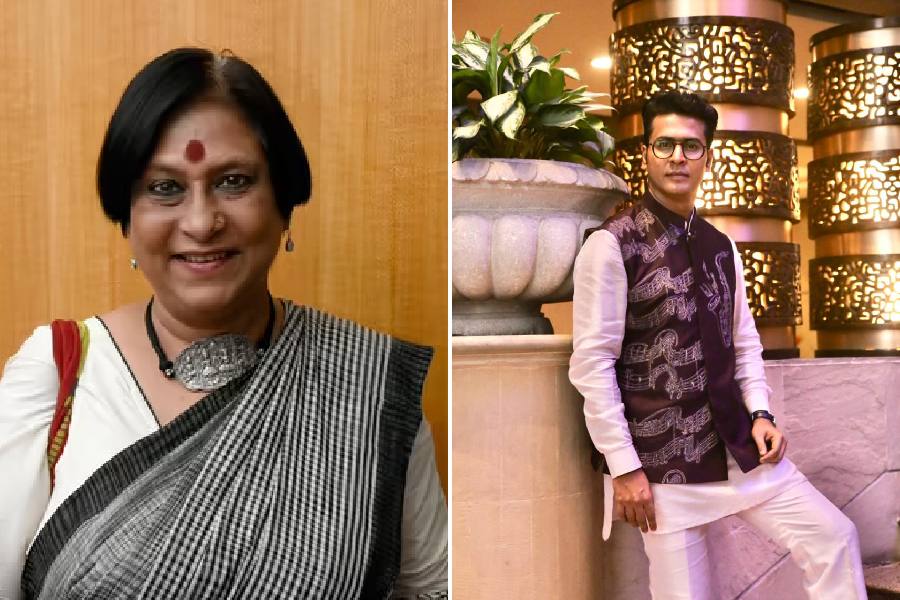 |
So how do you like your sushi? With tender raw meat that will melt in your mouth? Or with well-cooked meat that’s perfectly hand-rolled inside nori (layers of dried and pressed seaweed) or inside algae called makizushi?
What about your sashimi made from freshly-caught yellowtail or shrimp straight from Tokyo’s Tsukiji fish market? Perhaps, you’d like it with freshly grated wasabi? And would you care to wash it down with a chilled glass of shochu and not sake for a change? Shochu’s a distilled beverage that’s slightly stronger than wine and sake.
 |
Or you could even combine the sashimi with a Japanese single malt. Japanese single malts are highly rated by experts and are on sale now in many Japanese restaurants in India.
It’s an unlikely love affair. Indian gourmets and healthy, lightly cooked Japanese food. And most Japanese restaurants are offering new options for those willing to experiment.
“Japanese is the new flavour of the age. Discerning diners are looking for something new and since Japanese food is healthy, people are hooked on to it,” declares Amit Chowdhury, executive chef at Delhi’s The Taj Mahal Hotel.
“The food is steamed and grilled thus making it light and healthy,” says Nariyoshi Nakamura, corporate executive chef of Sakura restaurant in The Metropolitan in Delhi.
The choice of food on offer at Japanese restaurants in India is also expanding. At Harima restaurant in Bangalore, the 30-year-old executive chef Hiroshi Sakemato is careful to offer the real deal. “We serve authentic Japanese and avoid fusion Japanese unlike many Japanese restaurants in India,” he says.
How have Indians developed a taste for a very different cuisine? “It’s something that grows on you after you have tried it once or twice,” explains Vaibhav Chadda, director, Tamura, a chain of Japanese restaurants started by his family 10 years ago when the cuisine was almost unavailable here. Now Chadda’s family is poised to open their fourth Japanese restaurant in April in Delhi along with their partner Takayaki Tamura, a Japanese chef after whom the chain is named.
As the Japanese food bandwagon rolls on, its protagonists insist that it’s easy to like. Sabyasachi Gorai, known as Saby, is the executive chef at Ai, a Japanese restaurant that opened less than a year ago in the Capital. Says Saby: “It’s easy to acquire the flavour provided you don’t have any food allergy. I would say it’s a must-try because it’s tasty, easy to digest, light and low on sugar and calories.”
Fresh takes
The real essence of Japanese food lies in the ingredients. And there’s clearly no compromise on that. “The fresher they are the better,” says Taj’s Amit Chowdhury who gets his weekly supply of fresh ingredients from Tokyo. Most restaurants source their raw materials from Tokyo’s Tsujiki Market, probably the world’s biggest wholesale fish and seafood market. “We fly in once a week through our supplier,” says Saby.
Most places use fresh wasabi, quite expensive at Rs 12,000 per kilo and a short shelf life of about 15 days. At Kanomi at the Trident Hotel in Gurgaon, freshly grated wasabi is served with every single item. “Sometimes we run out of it since our consumption is so high,” says Ravitej Nath, executive chef.
Learning curve
 |
The best chefs reckon that there are no real shortcuts to good Japanese food. “You need to understand it from every aspect,” says Chowdhury. And he should know what he’s talking about because before the opening of the 54-cover Wasabi by Morimoto last year at Delhi’s The Taj Mahal Hotel, sous chef Achal Aggarwal was sent to Morimoto’s restaurant (he’s their partner) in New York to train for a month. In addition, Morimoto himself trained the in-house staff for two weeks in Delhi. “I understood the nuances of the cuisine and learning how restaurants like Morimoto’s deal with the weekend rush was a lesson in itself,” says Aggarwal.
At Ai too the kitchen team had to undergo extensive training before the restaurant opened. The team underwent several months of training by chefs from Japan. “It entailed getting to know and working with best quality Japanese raw materials, theory and class room training, Japanese cuisine vocabulary and Japanese names,” says Saby.
New notes
The newer Japanese restaurants are offering lots of new dishes. At Wasabi by Morimoto for instance, diners can sample unusual Japanese desserts like Wasabi sorbet and Wasabi crème brûée. The food here goes from raw to steamed, grilled and smoked. You can even try out the smoked eel or smoked salmon for which a special wood is flown from Japan.
The restaurant is carving out a niche for itself by serving modern Japanese cuisine. Chowdhury has also introduced pre-plated food here.
There’s also a Kaiseki menu (a meal consisting of several small dishes like steamed, simmered, grilled, soup or even raw fish). “The presentation is fancy but the essence remains the same. We have infused some flavours like cooking meat that we roll and give in tempura or batter fry,” says Chowdhury.
Home delivery
You’ve seen pizzas being delivered at your doorstep. Now, how about sushi at your front door? That’s how Sushi King was born in 2007. For software professionals Deepa and Sandeep Bansal, their love of sushi began during a holiday in — believe it or not — New Zealand eight years ago, where Deepa first tasted sushi. The Bansals went to work at once and roped in professional headhunters to hire the right staff. “We interviewed chefs both in India and abroad,” says Sandeep. They started by offering home delivery and catering services in Gurgaon. Their delivery service was a hit in just a few months. About 60 per cent of their clients are from Gurgaon and 40 per cent from Delhi. The Bansals then opened Sushi King, a Japanese restaurant in Gurgaon.
The Bansals have an offering called takara priced at Rs 1,599 which includes a variety of dishes including ebi-spa rolls, salmon hosomaki, and spicy tuna hosomaki and two pieces of Nigiri of salmon.
Then, there’s the Takeshi Party Roll (Takeshi means brave in Japanese). This has 60 pieces of assorted roll for Rs 2,499. What added to their popularity was that the menu had enough vegetarian options. “I want sushi to be a household name and bring it out from five-star surroundings,” says Deepa.
Innovation
 |
 |
Innovation is definitely the name of the game at many restaurants. At Konomi, the 22-cover Japanese restaurant at Trident hotel that opened last June, Chef Ravitej Nath and his colleague Chef Ramon Chavez Semeira offer up different variations of Japanese food. “Go with an open mind when you are having Japanese food. The initial impression about Japanese food is that it’s kuccha. There are other parts of the cuisine that are not raw,” says Nath.
But Nath’s guests are quite well-educated about Japanese food and often know exactly what they want. Some regulars even call up Chef Semeira before reaching the restaurant. The real treat here is the yakitori counter where the menu includes skewers of Indian Ocean prawn, asparagus and bacon, red snapper, lamb dumplings, chicken mince yakitori, shitake and more.
The menu also has its Chef’s Signatures dishes like Tanuki salmon (salmon, jalapeno and tempura flakes), Shokunin (Blue fin tuna, tobiko, spring onion, tempura flakes, spicy mayonnaise) and more.
Ambience works
Atmosphere is crucial when you eat out. So, some restaurants offer the choice of dining in Japanese fashion. Take the Tamura chain of restaurants. Takayaki Tamura, the head chef, has ensured that the experience is as real as possible. Three-year-old Tamura at New Friends Colony market has soothing and simple interiors with tatami mats on the floor for diners, as well as wooden benches with cushions. Throw in soothing Japanese instrumental music in the background to complete the experience. The menu card is printed in both English and Japanese so that even customers from the Nippon islands feel at home. The group has also opened another 56-cover restaurant called Kyoto in Gurgaon.
Fusion fare
Then there are others like Sakura at the Metropolitan hotel that have opted for the fusion effect. Chef Nakamura’s version of fusion Japanese food includes delicacies like paneer or chicken roll for sashimi instead of salmon.
About 50 per cent of the restaurant’s clientele is Indian and the rest are foreigners. The Sunday brunch can be quite an experience with a lavish spread of assorted Japanese cuisine. Ingredients are mostly flown in from Japan and the menu is changed every two weeks.
The restaurant also organises three festivals in a year promoting Japanese food, each around a particular item. Also expect to pair your food with white wine that’s especially recommended with sushi. At the restaurant’s sister outlet in Gurgaon, diners love to hang about the sushi bar where they can pick sea food from a huge glass tank.
Pair it right
What about the drinks? One of the highlights at Wasabi by Morimoto is the sake bar at the restaurant’s entrance, which is well-stocked with the finest and relatively unknown (in India) Japanese beverages. They were the first to serve Japanese whisky after having a special tie-up with Nikka Distilleries, one of Japan’s most famous distillers.
Diners can also opt from the largest selection of sakes and eight different Japanese whiskies like 10 to 20-year-old Yoichi single malts. At Ai, the choice on offer is also wide and it includes shochu to Japanese beers like Sapporo and Asahi to even interesting cocktails and mocktails. And what’s a Japanese meal without green tea and gari, a popular Japanese ginger tea? With all that, the Japanese experience is truly complete.











